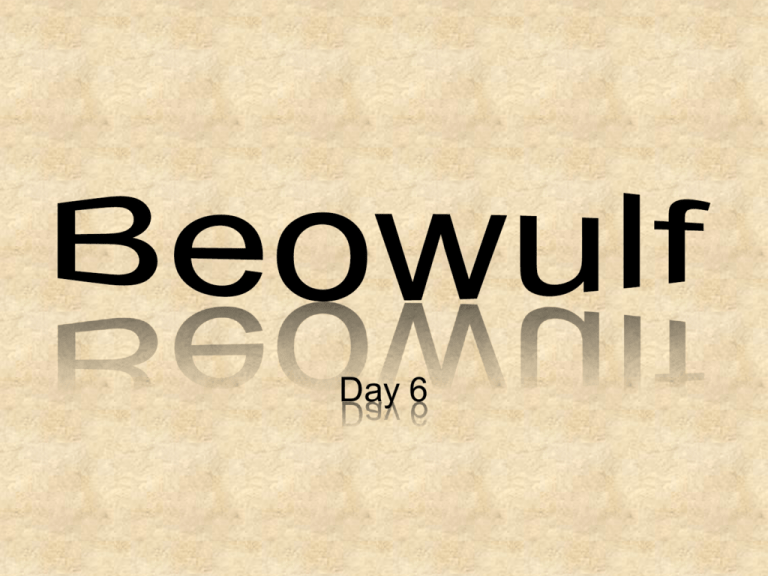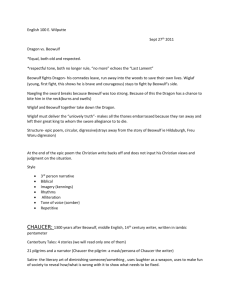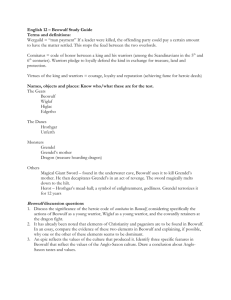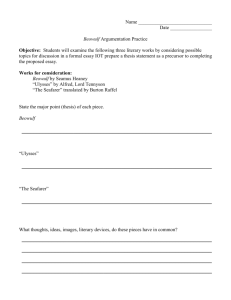Beowulf
advertisement

Day 6 Standards • • 2.0 Reading Comprehension (Focus on Informational Materials) Students read and understand grade-level-appropriate material. They analyze the organizational patterns, arguments, and positions advanced. 2.4 Make warranted and reasonable assertions about the author's arguments by using elements of the text to defend and clarify interpretations. 2.5 Analyze an author's implicit and explicit philosophical assumptions and beliefs about a subject. Writing 3.6 Analyze the way in which authors through the centuries have used archetypes drawn from myth and tradition in literature, film, political speeches, and religious writings (e.g., how the archetypes of banishment from an ideal world may be used to interpret Shakespeare's tragedy Macbeth). 3.7 Analyze recognized works of world literature from a variety of authors: a. Contrast the major literary forms, techniques, and characteristics of the major literary periods (e.g., Homeric Greece, medieval, romantic, neoclassic, modern). b. Relate literary works and authors to the major themes and issues of their eras. c. Evaluate the philosophical, political, religious, ethical, and social influences of the historical period that shaped the characters, plots, and settings. Objectives • Students will be able to… – – – – – compare and contrast identify and utilize read and respond analyze describe and predict Reading Check • Discuss and/or summarize the last reading with a partner. Make sure you are both on the same page as to what you understand from the reading. – The Last Battle Study Question CHeck 41. What characteristics do the dragon, on page 54, and Grendel have in common? 42. What characteristics do the dragon and Grendel have that are different? 43. What does Beowulf’s speech in lines 630-649 suggest to you about Anglo-Saxon values? 44. How does Beowulf plan to fight the dragon? 45. What do lines 717-740 reveal about the values of warrior culture? 46. According to Wiglaf, what is Beowulf’s relationship with his followers like? 47. What does Wiglaf’s decision suggest about the way in which a legendary hero can inspire heroism in others? 48. How do Beowulf’s companions react when the dragon breathes fire on him? 49. How does the battle end? 50. What does Beowulf ask Wiglaf to do? Art • Page 54: The Dragon by George Sharp – a contemporary British illustrator – created this painting for the book The High Kings, by Joy Chant – concerned with authenticity, so he spent many years researching the myths and legends of ancient England – Questions: • 1. What feelings do the various elements of content and color in this illustration create? • 2. Is this illustration appropriate for “The Last Battle”? Artifacts • Page 55: The Mammen Horse Collar – gold dragon head from a tenth-century horse collar – found at the Viking stronghold of Jutland – reveals Viking fascination with mythical beasts and intricate designs. – Questions: • 1. Why is this artifact an appropriate illustration for Beowulf? • How does this figure suggest the skill of Viking artisans? • Page 56: Gilt bronze winged dragon – eighth-century gilt bronze craftsmanship from Sweden – shows preference of real and mythical animals as art subjects, instead of humans and plants – less concerned with accurate representations than with creating complex, abstract, patterns – Questions: • 1. How does this artifact suggest that eighth-century Scandinavians were interested in abstract designs? • 2. Compare this dragon to the one on the previous page. The Spoils • lines 775-842 • Dragons are archetypal for greed and acquisitiveness, what lines in this passage support this and show that it is negative? • In Beowulf’s death scene, what is shown about the importance in warrior culture of the commemoration of individuals after death? • What is Beowulf’s last request? The Farewell • lines 843-869 • How does Beowulf’s death and burial compare to the traditions in our society? • What is Beowulf buried with? Why do you think the Scandinavian culture would do this? Review and Assess • Page 60: Thinking about the Selection – #1-7 • Page 61: Literary Analysis – #3-6 • Page 61: Extend Understanding – #9 Straight Boastin’ • In groups of five you will share your boast. – Every group member has one minute to share. – After all group members have shared, your group will have one minute to choose a “winner.” – Write “winner” on the paper of the chosen boast and then turn all boasts in. – The winning boasts will be presented to and voted on by another period.




